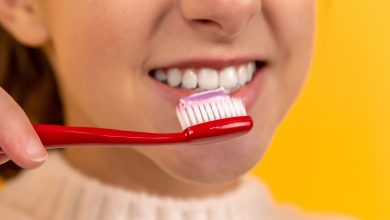When Does Tooth Decay Start? Tips to Prevent Early Decay

Tooth decay starts when bacteria in the mouth produce acids that attack the tooth’s enamel, leading to the formation of cavities. If left untreated, tooth decay can cause pain, infection, and even tooth loss.
Poor oral hygiene, consumption of sugars and starches, and failure to clean teeth properly can contribute to tooth decay. It is important to understand the stages of tooth decay and practice good oral hygiene to prevent its progression. Additionally, seeking timely treatment for tooth decay can help avoid further damage and the need for invasive dental procedures like root canals.
Common symptoms of tooth decay include toothache, sensitivity, visible holes or pits in teeth, staining, and pain when biting down.
The Role Of Bacteria In Tooth Decay
| Subheading | Information |
|---|---|
| Bacteria in the mouth and its effects on tooth enamel | Tooth decay begins when bacteria in your mouth make acids that attack the tooth’s surface (enamel). This can lead to a small hole in a tooth, called a cavity. If tooth decay is not treated, it can cause pain, infection, and even tooth loss. |
| Acid production and the attack on tooth’s surface | Tooth decay is the result of an infection with certain types of bacteria that use sugars in food to make acids. Over time, these acids can make a cavity in the tooth’s surface. When sugars and starches are not cleaned off the teeth, it provides an environment for the bacteria to produce more acids and continue the attack on the tooth’s surface. |
Tooth decay typically happens in five stages and can be prevented with good oral hygiene. It is caused by the bacteria in your mouth turning sugar into energy and producing acid that damages the teeth. The process of tooth decay starts with the formation of plaque on the teeth, which can be measured within an hour of brushing. If left untreated, tooth decay can progress and lead to the loss of a large portion of the tooth, requiring extraction.
It is important to note that tooth decay can start as soon as a baby’s teeth come in, usually around six months of age. Parents should be aware of the potential for tooth decay and limit the consumption of sugary drinks and practice good oral hygiene from an early age.
While brushing is essential for maintaining oral health, it cannot stop the growth of a cavity. Once a cavity has reached the pulp chamber, it will require a root canal to treat. It is important to seek dental treatment as soon as possible to prevent the decay from worsening.
Tooth Decay Process Explained
Tooth decay starts when bacteria in the mouth produce acids that attack the enamel. This leads to the formation of cavities, which, if left untreated, can cause pain, infection, and tooth loss. It is important to maintain good oral hygiene and avoid consuming excessive sugars and starches to prevent tooth decay.
| Tooth decay begins when bacteria in your mouth make acids that attack the tooth’s surface (enamel). This can lead to a small hole in a tooth, called a cavity. If tooth decay is not treated, it can cause pain, infection, and even tooth loss. It’s due to eating a lot of sugars and starches and not cleaning your teeth well. Tooth decay typically happens in five stages, and it can be prevented with good oral hygiene. The development and progression of cavities can have a significant impact on oral health. Tooth decay occurs when foods high in carbohydrates, such as fruits, candy, bread, or milk, stick to the surface of your teeth. When plaque is allowed to build up, it can lead to tooth decay. Parents are often surprised to learn that tooth decay can begin as soon as a baby’s teeth come in, usually by age six months. For all the good brushing does, it will not eliminate the cavity. The bottom line is you do not have the power to stop your cavity from growing. If the cavity reaches the pulp of the tooth, it will require a root canal. |
Sugar And Starch Consumption
Tooth decay begins when bacteria in your mouth produce acids that attack the enamel. This can lead to cavities, pain, infections, and even tooth loss if left untreated. It is caused by consuming sugars and starches and not properly cleaning your teeth.
Sugar and starch consumption can directly contribute to tooth decay. When sugars and starches are consumed, the bacteria in your mouth produce acids that attack the tooth’s surface, leading to the formation of cavities. It is important to clean your teeth thoroughly after consuming sugars and starches to prevent the buildup of plaque and the subsequent production of acid. Tooth decay is a result of an infection caused by certain types of bacteria that use sugars from food to produce acids. This acid production over time can lead to the development of cavities. Good oral hygiene practices and regular dental check-ups are essential for preventing tooth decay.Inadequate Oral Hygiene Practices
| When Does Tooth Decay Start |
Tooth decay begins when bacteria in your mouth make acids that attack the tooth’s surface (enamel). This can lead to a small hole in a tooth, called a cavity. If tooth decay is not treated, it can cause pain, infection, and even tooth loss. It’s due to eating a lot of sugars and starches and not cleaning your teeth well. When sugars and starches aren’t cleaned off your teeth, plaque forms. The bacteria in plaque make acids that attack tooth enamel. Over time, these acids can weaken the enamel and cause decay. Tooth decay typically happens in five stages, and it can be prevented with good oral hygiene. Proper oral hygiene routines include brushing your teeth twice a day, flossing daily, and visiting your dentist regularly for cleanings and check-ups. By following these practices, you can help prevent tooth decay and maintain good oral health.
Crucial Dental Hygiene Habits
Tooth decay typically starts when bacteria in the mouth produce acids that attack the tooth’s surface (enamel), leading to cavities. This can cause pain, infection, and tooth loss if left untreated. It is important to practice good oral hygiene to prevent tooth decay.
When does tooth decay start? Tooth decay begins when bacteria in your mouth produce acids that attack the tooth’s surface, also known as enamel. This can result in the formation of a small hole called a cavity. If left untreated, tooth decay can cause pain, infection, and even tooth loss. The main cause of tooth decay is consuming excessive amounts of sugars and starches and not cleaning your teeth properly. When these sugars and starches are not removed from your teeth, they provide a food source for the bacteria in your mouth, leading to acid production and subsequent tooth decay. It is important to practice good oral hygiene to prevent tooth decay. This includes regular brushing techniques and recommended frequency, as well as the use of flossing and mouthwash to maintain optimal oral health.Nutrition And Diet Tips For Strong Teeth
Tooth decay begins when bacteria in your mouth make acids that attack the tooth’s surface (enamel). This can lead to a small hole in a tooth, called a cavity. If tooth decay is not treated, it can cause pain, infection, and even tooth loss. It’s due to eating a lot of sugars and starches and not cleaning your teeth well. When sugars and starches aren’t cleaned off your teeth, they can promote the growth of bacteria and formation of plaque, which ultimately leads to tooth decay.
| Foods to Avoid | Foods that Promote Healthy Teeth |
|---|---|
| Sugary snacks and candies | Fresh fruits and vegetables |
| Sodas and sugary drinks | Water and milk |
| Starchy foods like bread and chips | Whole grains and nuts |
By avoiding sugary and starchy foods and incorporating fresh fruits, vegetables, water, milk, whole grains, and nuts into your diet, you can promote healthy teeth and prevent tooth decay. Remember to also practice good oral hygiene by brushing twice a day, flossing daily, and visiting your dentist regularly for check-ups and cleanings.
Regular Dental Check-ups And Cleanings
Tooth decay starts when bacteria in the mouth produce acids that attack the enamel, leading to cavities. It can cause pain, infection, and tooth loss if left untreated. Proper oral hygiene and regular dental check-ups can help prevent tooth decay.
| Tooth decay begins when bacteria in your mouth make acids that attack the tooth’s surface (enamel). This can lead to a small hole in a tooth, called a cavity. If tooth decay is not treated, it can cause pain, infection, and even tooth loss. It’s due to eating a lot of sugars and starches and not cleaning your teeth well. When sugars and starches aren’t cleaned off your teeth, plaque starts to form. Plaque is a clear, sticky film of bacteria that constantly forms on your teeth. Over time, the acids made by the bacteria in plaque can weaken your tooth enamel and cause cavities. |

Credit: www.healthychildren.org
Frequently Asked Questions On When Does Tooth Decay Start
At What Age Do Your Teeth Start Decaying?
Tooth decay can start as soon as a baby’s teeth come in, usually around six months old. It is important to practice good oral hygiene and avoid sugary drinks to prevent tooth decay. Symptoms of tooth decay include toothaches, sensitivity, visible holes or staining on the teeth.
If left untreated, tooth decay can lead to pain, infection, and tooth loss.
Can You Stop Tooth Decay When It Starts?
Tooth decay starts when bacteria in your mouth produce acids that attack the tooth’s surface, causing a cavity. If left untreated, it can lead to pain, infection, and tooth loss. Unfortunately, once it starts, you cannot stop it from growing.
It may require a root canal if it reaches the pulp of the tooth.
How Do You Know If Your Teeth Are Starting To Decay?
Tooth decay symptoms include toothache, sensitivity to hot/cold/sweet foods, visible stains or holes in teeth, and pain when biting.
What Is Stage 1 Tooth Decay?
Stage 1 tooth decay is characterized by the presence of white spots on the tooth’s surface. It is caused by bacteria in the mouth producing acids that attack the enamel. Good oral hygiene and prevention methods can help stop the decay from progressing.
Conclusion
Tooth decay is a common dental issue that can lead to pain, infection, and tooth loss if left untreated. It begins when bacteria in the mouth produce acids that attack the tooth’s enamel, eventually causing cavities. Maintaining good oral hygiene, including regular brushing and flossing, is essential in preventing tooth decay.
Remember to limit the consumption of sugary and starchy foods as they contribute to the formation of acids. By taking proactive measures and seeking appropriate treatment when necessary, you can protect your teeth and maintain a healthy smile.





